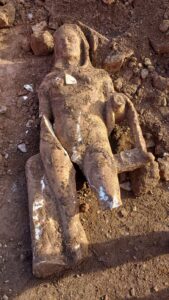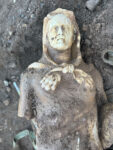 A life-sized marble statue of a Hercules figure has been discovered on the Appia Antica, the ancient road leading south out of Rome. He wears the skin of the Nemean lion, its open mouth on his head like a hat, its front paws tied at the clavicle like a scarf, its hind legs draped over his left arm. His facial features, however, do not match the iconography of Hercules. This is the portrait of a man wearing a Hercules suit.
A life-sized marble statue of a Hercules figure has been discovered on the Appia Antica, the ancient road leading south out of Rome. He wears the skin of the Nemean lion, its open mouth on his head like a hat, its front paws tied at the clavicle like a scarf, its hind legs draped over his left arm. His facial features, however, do not match the iconography of Hercules. This is the portrait of a man wearing a Hercules suit.
The statue was not found in an archaeological excavation, but during construction of a new sewer line. The failure of a 19th century pipeline was causing sinkholes to appear in the Archaeological Park of Appia Antica, requiring drastic action over a wide area to repair. Archaeologists have been working with the utilities crews throughout the complex project. Weeks of earth moving had returned no archaeological materials when suddenly Hercules emerged 20 meters (65 feet) below street level.
 The statue was unearthed on the second mile of the Appia Antica next to the Tomb of Priscilla (second half of the 1st century A.D.). It was found under the collapsed 19th century pipe that was being demolished by the earthmover. This was not its original location, but a secondary deposit. It was likely discovered during construction of the old sewer line and then just tossed into the soil layer underneath it. (There was zero archaeological oversight back then and people could well have chosen to simply bury the statue instead of going through the trouble of salvaging it.)
The statue was unearthed on the second mile of the Appia Antica next to the Tomb of Priscilla (second half of the 1st century A.D.). It was found under the collapsed 19th century pipe that was being demolished by the earthmover. This was not its original location, but a secondary deposit. It was likely discovered during construction of the old sewer line and then just tossed into the soil layer underneath it. (There was zero archaeological oversight back then and people could well have chosen to simply bury the statue instead of going through the trouble of salvaging it.)
Without stratigraphic information, determining the age of the statue is difficult. Comparison to other artifacts is pretty much all archaeologists have to go on, and they’ve begun to research comparable works. They already have a hypothesis for the identity for the man behind the lionskin: the 3rd century emperor Gaius Messius Quintus Traianus Decius, aka Trajan Decius.
During these very first analyses we found a decent resemblance between the portrait of our character in the costume of Hercules and Emperor Gaius Messius Quintus Traianus Decius, better known as Trajan Decius, who reigned from 249 to 251, when he was killed, along with his son Herennius Etruscus, in the Battle of Abrittus between Goths and Romans.
The face of “our Hercules”, although corroded, seems to share with the official portraits of Decius the “wrinkles of anxiety”, which recall Republican Roman portraiture and were aimed at representing the concern for the fate of the State, a virtue evaluated very positively in the high ranks of the empire. Other characteristic features are the treatment of the beard razor and the morphology of the eyes, nose and lips.
Decius was a senator and statesman before his soldiers acclaimed him imperator on the field, and during his brief reign, he made a priority of reviving traditional Roman virtues, religion and governance. He made himself consul every year, attempted to reinstitute the senatorial position of Censor (the magistrate who maintained the citizenship rolls) and promulgated the first official law persecuting Christians by demanding all Roman citizens sacrifice to Rome’s traditional gods for the safety and health of the emperor and empire.
 During his brief reign, he made his mark on Rome with public works, building a luxurious new bath complex on the Aventine frequented by the wealthy residents of the neighborhood. Little of it remains today, but two statues were recovered from the site and are now in the collection of the Capitoline Museums. One of them is an unusual monumental basalt statue of Hercules as a boy. He wears the skin of the Nemean Lion draped over his head, paws tied around his chest. He holds his iconic club in his right hand (only the handle of it remains) and the apples of the Hesperides and in his left. Presenting himself clothed in Hercules’ attributes would certainly be in keeping with Decius’ emphasis on promoting traditional Roman virtues.
During his brief reign, he made his mark on Rome with public works, building a luxurious new bath complex on the Aventine frequented by the wealthy residents of the neighborhood. Little of it remains today, but two statues were recovered from the site and are now in the collection of the Capitoline Museums. One of them is an unusual monumental basalt statue of Hercules as a boy. He wears the skin of the Nemean Lion draped over his head, paws tied around his chest. He holds his iconic club in his right hand (only the handle of it remains) and the apples of the Hesperides and in his left. Presenting himself clothed in Hercules’ attributes would certainly be in keeping with Decius’ emphasis on promoting traditional Roman virtues.